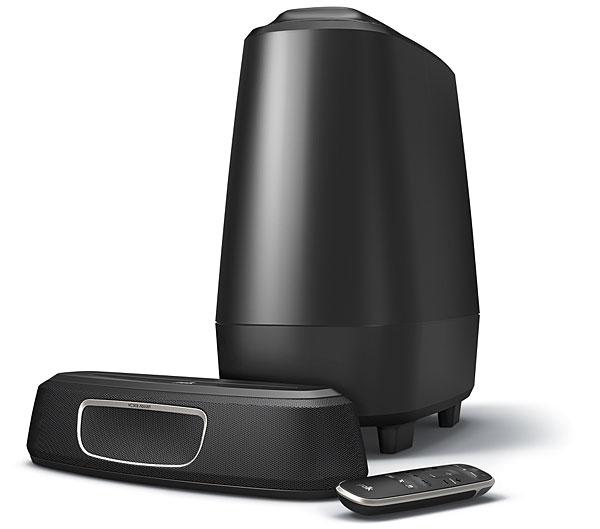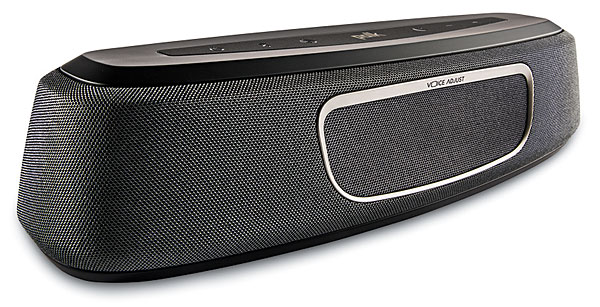Polk MagniFi Mini Soundbar System Review

AT A GLANCE
Plus
Big sound from a tiny speaker
Carefully voiced with
neutral tonal balance
Minus
No HDMI video passthrough
Sub’s performance limited by its small size
THE VERDICT
Despite its diminutive size, the MagniFi Mini speaks with a loud and clear voice at a bargain price.
Why is it that every year, TVs seem to get bigger while speakers seem to get smaller? Back when Stereo Review became Sound & Vision, a nice home theater had a 34-inch tube TV and a decent 5.1channel surround sound system with floorstanding tower speakers. Now, many years later, the TV has grown to 65, 70, or even 80 inches, but the speakers have shrunk to the point where they’re small enough to get lost at the bottom of the massive screen.
Perhaps we simply need to recalibrate our thinking. Back when cars with big V8 engines ruled the day, the car guys would say that there’s no replacement for displacement. But today, you can get a brand-new 2017 Mustang with a puny 2.3-liter EcoBoost four-banger that cranks out a tire-twisting 335 horsepower. So maybe, given advancements in drivers and digital signal processing, the same kind of more-from-less thinking can be applied to speaker design.
Polk wasn’t kidding when they called this speaker the MagniFi Mini. If you took off your shoe and plopped it onto the table in front of your TV, the speaker would pretty much disappear. Well, OK, maybe if you happen to have feet like Shaq’s—but I think you get my drift. This little thing promises huge sound from a tiny box, so I put it through its paces to see if it could deliver the goods.

At just a little over a foot wide and small enough around to be gripped comfortably with one hand, the MagniFi Mini soundbar looks more like a decent-sized Bluetooth speaker that you might take to the beach for some portable tunes, instead of something you’d hook up permanently to your TV. Packed inside of that compact form are no fewer than six drivers, arranged in two sets of three, with each set offering a pair of 2.25-inch woofers flanking a 0.5-inch tweeter. The outer drivers sit toward the ends of the bar, in a manner that points them away from the centerline, to spread out the sound. While the soundbar with its companion subwoofer is in essence a 2.1-channel setup, it is capable of decoding Dolby Digital 5.1 sources and also uses a DSP-based version of the company’s well-known SDA (stereo dimensional array) technology to deliver a bigger soundstage than would usually be expected from such a small speaker. Polk says this combination of SDA and their new patent-pending acoustic array is what allows the Mini to achieve its extraordinary imaging.
To make bass, you still need something a bit bigger than half a shoebox, so the MagniFi Mini has that companion subwoofer, which looks a little like a small home-office paper shredder. With a downward-firing 6.5-inch woofer, the ported sub can be tucked away inconspicuously next to your TV cabinet. It communicates wirelessly with the soundbar, so the only cable the sub needs is its power cord.
Making the Connection
Many soundbars have an HDMI input where you can connect your source, as well as another HDMI connector to pass the video signal to your TV. Polk, however, has taken a different approach, using the audio return channel (ARC) on the HDMI signal to deliver sound directly from the TV. This way, you use the TV set as your source selector, and the soundbar doesn’t handle the video signal at all.

That’s great if you have a TV made in the last few years that includes HDMI 1.4 with ARC, but it’s not so great if you have older equipment. It also means that one of your TV’s HDMI jacks will be used by the soundbar, which may leave you one HDMI input short if you have a lot of source components to hook up. In that case, the next option is the optical digital input, which you can hook up to the digital output found on most TVs. Lastly, if all else fails, there’s a 3.5mm analog stereo minijack input that you can connect to your TV’s headphone jack. One nice touch is that cables for all of these potential connections are included in the box, so you won’t be scrambling for the nearest electronics store to get everything connected. [Ed. Note: If you do use the TV’s optical connection, set its audio menu to output a multichannel Dolby Digital 5.1 bitstream if that’s an option to take full advantage of the Mini’s built-in multichannel DD decoder for the best sound. Not all TV’s allow this, but a simple two-channel stereo Dolby Digital bitstream would be the next best and is found in most sets. After that, straight PCM stereo will be your only option.—RS]
A wired connection makes sense for the TV sound, but the MagniFi Mini also features Bluetooth and Wi-Fi-based Google Cast wireless for playing music from your smartphone or tablet. The Bluetooth streams directly from your device, but the Google Cast app ties the MagniFi Mini into your home network and lets you use Chromecast-compatible apps to get around the data compression used in Bluetooth for better sound quality. There’s also a hard-wired Ethernet connection that you can use instead of Wi-Fi if you happen to have a network outlet nearby.
I was happy to find that, instead of one of those tiny credit-card-style remotes you usually get with a soundbar, the MagniFi Mini comes with a really nice-feeling and wellthought-out clicker. It doesn’t have illuminated buttons, but you don’t really need them because it has been designed to be easily operated by feel alone. The volume up and down buttons sit in a kind of groove in the middle of the remote, making them easy to locate, and the other buttons are all logically positioned. Some of the key controls are also duplicated on the top of the soundbar, which is good news if, like me, you have a tendency to lose remotes deep within the couch cushions.



























































